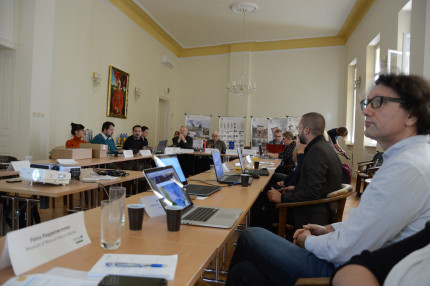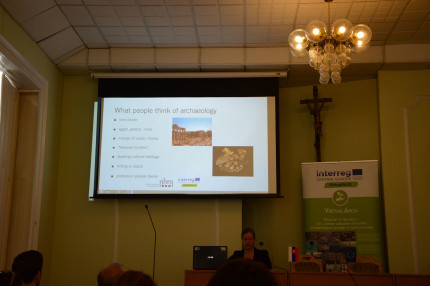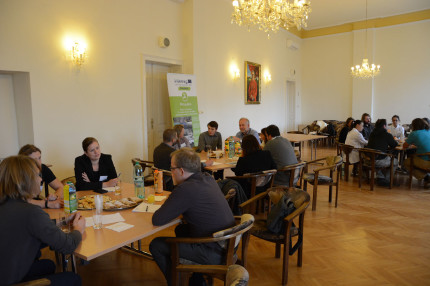Transnational Stakeholder Workshop “Public archaeology and the use of innovative media and visualization tools”
Nitra, 23th October 2018
Main objective of the meeting in the cleric seminary of St. Gorazd was to discuss the importance of public participation in archaeology / heritage management and the use of innovative media and visualization tools as an inevitable strategy. More than 50 international participants from archaeology and volunteering came together, present the status quo (esp. in Slovakia), current projects, useful techniques and best practice examples from all over Europe in 7 “keynotes”. Based upon it, the participants discussed 3 topics in the afternoon following the successful “World Café” approach. Results of table discussions were presented by table moderators and LP representative finally summed up results for all participants.

The meeting started with opening words by M. Ruttkay, director of the hosting organization (Archaeological Institute of Slovak Academy of Sciences) and by the project leader C. Hemker. After that, presentations began by Z. Ondrejková, providing an introduction of the typology of archaeological site presentation in Slovakia. She gave us an overview and critical reflections of examples over the decades. She pointed out the highly value of volunteer workers and associations as multipliers and as public actors in raising awareness. She also showed some controversial types of presentation, such as displaying floors in the side view in the height of observer´s eyes.
Keynote 1 was presented by P. Herceg illustrating the numerous civic organizations collected in the NGO “Save the Ruins” and it´s work for last 16 years. The main aim was to show the progress that was made, from the somehow “enthusiastic” approach at the end of the 90´s of the 20th century up to the recent years. Nowadays, the hard manual labour, connected with the rebuilding of the damaged ruins by using the traditional techniques, is going hand in hand with the modern methods of presentation: 3D technologies.
Keynote 2 held by D. Mikulík from Castle and Museum Stará Ľubovňa showcased the 3D presentation using holograms, VR and AR to show the different building periods and finds. He also presented “making of” video of the 3D reconstruction of the building process that will be shown at the museum. The importance of this keynote was showing also the complicated process of searching all information for the reconstruction to be as accurate as possible: from the archaeological survey to searching in archives. He also pointed out, that the 3D presentation by itself is not aim, but a tool to present the historical and archaeological research to public.
The technical possibilities nowadays in the field of 3D heritage recording was demonstrated by M. Bujňák from Capturing Reality in Keynote 3 on “Software for digitization of archaeological cultural heritage”. Beside the more elaborate laser scanning the method of “structure from motion” is based on simple pictures from cameras or even mobile phones. With free or low priced software even non-professionals and volunteers could create virtual models of heritage in their region.
Beside the local “on-site-public-participation” also the internet is a growing area of activity. Keynote 4 on “Open science approaches as challenge for archaeological stakeholders” was held by S. Rotermund and H. Buchmann, two young Students from Germany. In times of citizen scientism, fake news, demand of transparency and changed media consumption, archaeological actors have to rethink their strategies bringing up also new priorities and communication languages. The speakers told the audience their experience with the project “Anarchäologie” and pointed out necessary changes. It was also shown during the discussion that the scientists want to open themselves, but often lack tools, personnel or finances and experiences to do so.
Keynote 5 on “Social Media in Archaeology – reaching new target groups” was held by a project team member, F. Poppenwimmer from the Natural History Museum Vienna. Based on her experiences with the “Stiegen-Blog”, she debated the demands and benefits of a successful web blog like the public engagement and diverse audience, shared emotions and feedback, the permanent presence and information posting, changed personal writing style as well as reflecting daily work due to immediate publication.

In keynote 6 Bert Ludwig from the European Heritage Volunteers presented his organisations, their aims and experiences from different projects all over Europe, primarily with young academics and graduates. He pointed at the different view on Europe, not only as the countries of European union, but in the geographical point of view. The cultural heritage is rich also in countries, that are yet somehow out of the scope of westerners: for example Albania, Armenia, Georgia or Belarus.
The last keynote was done by P. Jenčík from the civic organization “Hradiska (Hillforts)” illustrating a fine example of volunteering and cooperation with archaeological institutes and great success of virtual reconstructions (together with DWARF Digital team) as communication method with great outreach (several thousand views on facebook and youtube). The importance of the cooperation of the volunteers with the scientists is visible also on the reconstructions that are getting more and more accurate.
There was also held a press conference between the keynotes, where C. Hemker, M. Ruttkay and Jiri Unger presented the VirtualArch project for the public TV and radio, main press agency SITA and regional journalists (klick here for the report of the national TV in their primetime news from min. 45:20).
Results of “World Café” discussions
Based on key note speeches and experiences of participants the following topics have been discussed at round tables following the principle “World Café” approach:
- Social media and open science: is it use- or harmful?
- Volunteers, private actors and NGO – partners and opponents to professionals?
- VR-AR-presentation – chances for volunteer, small museums and private actors?
On first table participants discussed about general issues like the “openness of science”, the benefits of social media for attention making and contact holding as well as the necessity of employment media experts in archaeological institutions. Although there is often no real scientific discussion, it starts to be also an important rating form for evaluation – a journey we hardly could forecast now.

On second table participants explained the importance that professionals in case of cooperation has to set up borders and guidelines for volunteers. But there is also huge increase of volunteers, depending on age, topic orientation, former profession and personal interest. Also the way of public participation and volunteering is changing – from traditional surveying to metal detecting nowadays which requires also a change in professional education and training. Although a heavy timely and personal burden for heritage offices, volunteering and a thin cooperation could be also a chance like the discovery of so far unknown heritage sites and types.
A great issue at the third table and (virtual) reconstruction of archaeological heritage is the “Maybe how it looked like”. Here VR/AR and an open accessible home kit could give new possibilities. But users and professionals should be apply them careful, so fake reconstructions could be avoided. Archaeologists still have to follow an ethical path, we have an educational mission and our provided digital data is no simple playground.
